On the Fluid Behavior Response Characteristics During Early Stage of CBM Co-Production in Superimposed Pressure Systems: Insights from Experimental Analysis
Abstract
1. Introduction
2. Simulation Test Method
2.1. Simulation Test Device
2.2. Coal Reservoir Design and Material Selection
2.3. Test Scheme and Steps
2.4. Definition of Relevant Parameters
3. Test Results and Analysis
3.1. Influences of Well-Hole Fluid Confluences on the Pressure Field
3.2. Influences of Well-Hole Fluid Confluences on the Flow Field
3.3. Influences of Well-Hole Fluid Confluences on Gas Production Characteristics
4. Conclusions
- Current laboratory research primarily focuses on seepage experiments involving series-parallel core samples, while large-scale physical simulation studies on CBM development in superimposed pressure systems are scarce. This study replicates the indoor simulation of superimposed pressure systems, which involve multiple pressure systems coexisting within a reservoir, providing a new approach for the safe and efficient extraction of superimposed pressure systems.
- Based on the characteristics of superimposed pressure systems, the reconstructed coal simulates the coal reservoir and provides the occurrence place of CBM. The impermeable gas barrier of clay is used as the low-permeability thick rock strata to cut off the fluid connection between coal reservoirs. This work provides a new research approach for revealing fluid disturbance mechanisms and guiding CBM development.
- The convergence and mixing of fluids from coal reservoirs exhibiting distinct pressure characteristics within the main well hole generate a fluid disturbance effect. The evolution process of well-hole pressure is categorized into two stages: the confluence disturbance stage and the confluence pressure drop stage. Due to well-hole fluid confluences, the well-hole pressure of branch well-holes in the corresponding low-pressure coal reservoirs increases in terms of reservoir pressure. This increase in pressure leads to fluid exchanges between the coal reservoirs and well-holes, manifesting in terms of production.
- Based on the differences between the fluid disturbance effects of CBM co-production modes, a compatibility method of dynamic characterization has been put forward. The pressure compatibility and production compatibility coefficients exhibit rapid growth during the early stages, followed by a gradual decline during the middle and later stages. The worst compatibility is witnessed during the early stage of co-production, but the compatibility will improve the extension of co-production time.
- Optimizing production strategies for superimposed pressure systems involves implementing a progressive co-production schedule. The core of this schedule lies in the dynamic introduction of gas-bearing layers: initially extracting CBM from high-pressure coal reservoirs and, once the reservoir pressure decreases to a level comparable to that of low-pressure reservoirs, co-producing CBM from the low-pressure reservoirs. The primary objective of this approach is to achieve uniform reservoir pressure (i.e., similar fluid energy) across the superimposed pressure systems, thereby minimizing fluid disturbance effects during CBM co-production and ultimately enhancing recovery efficiency.
- This research is currently focused on the flow characteristics of superimposed pressure systems within the reservoir. Future studies should prioritize investigating the coupling effects of low porosity and permeability, gas-water two-phase seepage, the coexistence of multi-phase natural gas, and multi-type reservoirs on the dynamic evolution of the fluid behavior response characteristics induced by fluid interference. Additionally, it is essential to clarify the mechanisms and impacts of reservoir damage caused by the invasion of different fluid phases during CBM co-production and to reveal the coupled flow characteristics of interlayer crossflow and wellbore pipe flow.
Author Contributions
Funding
Data Availability Statement
Acknowledgments
Conflicts of Interest
References
- National Bureau of Statistics of the People’s Republic of China. Development of the People’s Republic of China in 2021. In Statistical Bulletin of National Economic and Social Development; National Bureau of Statistics: Beijing, China, 2022. [Google Scholar]
- Liu, H.; Su, G.; Okere, C.; Li, G.; Wang, X.; Cai, Y.; Wu, T.; Zheng, L. Working fluid-induced formation damage evaluation for commingled production of multi-layer natural gas reservoirs with flow rate method. Energy 2022, 239, 122107. [Google Scholar]
- Pourhoseini, S.H. Enhancement of radiation characteristics and reduction of NOx emission in natural gas flame through silver-water nanofluid injection. Energy 2022, 194, 116900. [Google Scholar]
- Quan, F.; Wei, C.; Ma, J.; Hao, S.; Song, Y. Modeling analysis of coalbed methane co-production interference: A case study in Eastern Yunnan Basin, China. J. Nat. Gas Sci. Eng. 2022, 103, 104631. [Google Scholar]
- Huang, H.; Bi, C.; Sang, S.; Miao, Y.; Zhang, H. Signature of coproduced water quality for coalbed methane development. J. Nat. Gas Sci. Eng. 2017, 47, 34–46. [Google Scholar]
- Wang, Z.W.; Qin, Y. Physical experiments of CBM co-production: A case study in Laochang district, Yunnan province, China. Fuel 2019, 239, 964–981. [Google Scholar]
- Guo, C.; Qin, Y.; Sun, X.; Wang, S.; Xia, Y.; Ma, D.; Bian, H.; Shi, Q.; Chen, Y.; Bao, Y.; et al. Physical simulation and compatibility evaluation of multi-seam CBM co-production: Implications for the development of stacked CBM systems. J. Petrol. Sci. Eng. 2021, 204, 108702. [Google Scholar]
- Li, S.; Tang, D.Z.; Pan, Z.J.; Xu, H.; Guo, L.L. Evaluation of coalbed methane potential of different reservoirs in western Guizhou and eastern Yunnan, China. Fuel 2015, 139, 257–267. [Google Scholar]
- Lau, H.; Li, H.; Huang, S. Challenges and opportunities of coalbed methane development in China. Energ. Fuel 2017, 31, 4588–4602. [Google Scholar]
- Qin, Y.; Moore, T.A.; Shen, J.; Yang, Z.B.; Shen, Y.L.; Wang, G. Resources and geology of coalbed methane in China: A review. Int. Geol. Rev. 2018, 60, 777–812. [Google Scholar]
- Qin, Y.; Wu, J.G.; Zhang, Z.G.; Yi, T.S.; Yang, Z.B.; Jin, J.; Zhang, B. Analysis of geological conditions for coalbed methane co-production based on production characteristics in early stage of drainage. J. China Coal Soc. 2020, 45, 241–257. [Google Scholar]
- Wang, Z.W. Simulation and Geological-Mathematical Models of CBM Co-Production Interference: A Case of Longtan Formation in Western Guizhou and Eastern Yunnan, China; China University of Mining and Technology: Xuzhou, China, 2021. [Google Scholar]
- Qin, Y.; Wu, J.G.; Shen, J.; Yang, Z.B.; Shen, Y.L.; Zhang, B. Frontier research of geological technology for coal measure gas joint-mining. J. China Coal Soc. 2018, 43, 1504–1516. [Google Scholar]
- Liang, B.; Shi, Y.; Sun, W.; Fang, S.; Jia, L.; Zhao, H. Experiment on influence of inter layer spacing on combined desorption of double-layer coalbed methane reservoir. J. China Univ. Min. Techno. 2020, 49, 54–61. [Google Scholar]
- Guo, X. Production Prediction of Multilayered CBM Reservoirs and Optimization of Production Strategy; China University of Petroleum: Beijing, China, 2019. [Google Scholar]
- Liu, L. Experimental Study on Interlayered Crossflow of Multilayered CBM Reservoir in Eastern Yunnan and Western Guizhou; China University of Petroleum: Beijing, China, 2019. [Google Scholar]
- Zheng, L.; Li, X.; Su, G.; Zhao, W.; Kong, X.; Tao, X. Applicability of working fluid damage assessment methods for coalbed methane reservoirs. Nat. Gas Ind. 2018, 38, 34–45. [Google Scholar]
- Zheng, L.; Tao, X.; Wei, P.; Wu, T.; Liu, H.; Cao, Z. Multi-reservoir production damage physical simulation system and its application in coal-measure gas production. J. China Coal Soc. 2021, 46, 2501–2509. [Google Scholar]
- Wang, L.; He, Y.; Wang, Q.; Liu, M.; Jin, X. Improving tight gas recovery from multi-pressure system during commingled production: An experimental investigation. Nat. Resour. Res. 2021, 30, 3673–3694. [Google Scholar]
- Liu, G.F.; Meng, Z.; Luo, D.Y.; Wang, J.N.; Gu, D.H.; Yang, D.Y. Experimental evaluation of interlayer interference during commingled production in a tight sandstone gas reservoir with multi-pressure systems. Fuel 2020, 262, 116557. [Google Scholar]
- Wang, L.; Yang, S.L.; Liu, Y.C.; Xu, W.; Deng, H.; Meng, Z.; Han, W.; Qian, K. Experiments on gas supply capability of commingled production in a fracture-cavity carbonate gas reservoir. Petrol. Explor. Dev. 2017, 44, 824–833. [Google Scholar]
- Xu, J.; Zhang, C.L.; Peng, S.J.; Jia, L.; Guo, S.C.; Li, Q.X. Multiple layers superposed CBM system commingled drainage schedule and its optimization. J. China Coal Soc. 2018, 43, 1677–1686. [Google Scholar]
- Xiong, Y.; Zhang, L.; Yang, F.; Lu, Y.; Hu, S. Study on technical policy and threshold value of multiple-zone production with one well for multi-layered gas reservoir. Nat. Gas Ind. 2005, 25, 81–83. [Google Scholar]
- Fu, X.; Ge, Y.; Liang, W.; Li, S. Pressure control and fluid effect of progressive drainage of multiple superposed CBM systems. Nat. Gas Ind. 2013, 35, 35–39. [Google Scholar]
- Jiang, W.; Wu, C.; Wang, Q.; Liu, Y. Interlayer interference mechanism of multi-seam drainage in a CBM well: An example from Zhucang syncline. Int. J. Min. Sci. Technol. 2016, 26, 1101–1108. [Google Scholar]
- Li, Y.; Meng, S.; Wu, P.; Wang, Z.; Yu, Z. Numerical simulation of coal measure gases co-production. J. China Coal Soc. 2018, 43, 1728–1737. [Google Scholar]
- Wang, S.; Wang, Y.; Zhang, Z.; Li, Z.; Feng, Y. Analysis of influencing factors on productivity of coalbed methane of combined multi-layer drainage wells. Coal Sci. Technol. 2019, 47, 126–131. [Google Scholar]
- Wang, Z.; Qin, Y.; Li, T.; Zhang, X. A numerical investigation of gas flow behavior in two-layered coal seams considering interlayer interference and heterogeneity. Int. J. Min. Sci. Technol. 2021, 31, 699–716. [Google Scholar]
- Zhang, C.; Xu, J.; Yin, G.; Peng, S.; Li, Q.; Chen, Y. A novel large-scale multifunctional apparatus to study the disaster dynamics and gas flow mechanism in coal mines. Rock Mech. Rock Eng. 2019, 52, 2889–2898. [Google Scholar]
- Zhang, C.; Xu, J.; Peng, S.; Li, Q.; Yan, F. Experimental study of drainage radius considering borehole interaction based on 3D monitoring of gas pressure in coal. Fuel 2019, 239, 955–963. [Google Scholar]
- Qin, Y.; Xiong, M.H.; Yi, T.S.; Yang, Z.B.; Wu, C.F. On unattached multiple superposed coalbed-methane system: In a case of the Shuigonghe syncline, Zhijin-Nayong coalfield, Guizhou. Geol. Rev. 2008, 54, 65–70. [Google Scholar]
- Shen, Y.L.; Qin, Y.; Guo, Y.H.; Yi, T.S.; Yuan, X.X.; Shao, Y.B. Characteristics and sedimentary control of a coalbed methane-bearing system in Lopingian (late Permian) coal-bearing strata of western Guizhou province. J. Nat. Gas Sci. Eng. 2016, 33, 8–17. [Google Scholar]
- Shen, Y.L.; Qin, Y.; Wang, G.G.X.; Guo, H.Y.; Shen, J.; Gu, J.Y.; Xiao, Q.; Zhang, T.; Zhang, C.L.; Tong, G.C. Sedimentary control on the formation of a multi-superimposed gas system in the development of key layers in the sequence framework. Mar. Petrol. Geol. 2017, 88, 268–281. [Google Scholar]
- Shen, Y.L.; Qin, Y.; Wang, G.G.X.; Xiao, Q.; Shen, J.; Jin, J.; Zhang, T.; Zong, Y.; Liu, J.B.; Zhang, Y.J.; et al. Sealing capacity of siderite-bearing strata: The effect of pore dimension on abundance and micromorphology type of siderite in the Lopingian (Late Permian) coal-bearing strata, western Guizhou province. J. Petrol. Sci. Eng. 2018, 178, 180–192. [Google Scholar]
- Arenillas, A.; Pevida, C.; Rubiera, F.; Pis, J. Comparison between the reactivity of coal and the synthetic coal models. Fuel 2003, 82, 2001–2006. [Google Scholar]
- Jessen, K.; Tang, G.; Kovscek, A. Laboratory and simulation investigation of enhanced CBM recovery by gas injection. Transp. Porous. Med. 2008, 73, 141–159. [Google Scholar]
- Jasinge, D.; Ranjith, P.; Choi, S. Effects of effective stress changes on permeability of Latrobe Valley brown coal. Fuel 2011, 90, 1292–1300. [Google Scholar]
- Dutka, B.; Kudasik, M.; Pokryszka, Z.; Skoczylas, N.; Topolnicki, J.; Wierzbicki, M. Balance of CO2/CH4 exchange sorption in a coal briquette. Fuel Process Technol. 2013, 106, 95–101. [Google Scholar]
- Sobczyk, J. A comparison of the influence of adsorbed gases on gas stresses leading to coal and gas outburst. Fuel 2014, 115, 288–294. [Google Scholar]
- Arenillas, A.; Pevida, C.; Rubiera, F.; Pis, J. Characterisation of model compounds and a synthetic coal by TG/MS/FTIR to represent the pyrolysis behavior of coal. J. Anal. Appl. Pyrol. 2004, 71, 747–763. [Google Scholar]
- Sobczyk, J. The influence of sorption processes on gas stresses leading to the coal and gas outburst in the laboratory conditions. Fuel 2011, 90, 1018–1023. [Google Scholar]
- Dutka, B.; Kudasik, M.; Topolnicki, J. Pore pressure changes accompanying exchange sorption of CO2/CH4 in a coal briquette. Fuel Process Technol. 2012, 100, 30–34. [Google Scholar]
- Li, Q.; Xu, J.; Peng, S.; Yan, F.; Han, E.; Jiang, C. Physical simulation experiment on flow characteristics in a low-pressure reservoir under co-production. J. China Coal Soc. 2021, 46, 351–363. [Google Scholar]
- Wen, Z.; Kang, Y.; Deng, Z.; Sun, L.; Li, G.; Wang, H. Characteristics and distribution of current in-situ stress at shallow-medium depth in coal-bearing basins in China. Geol. Rev. 2019, 65, 729–742. [Google Scholar]
- Zhang, Z.; Qin, Y.; Yang, Z.; Jin, J.; Wu, C. Fluid energy characteristics and development potential of coalbed methane reservoirs with different synclines in Guizhou, China. J. Nat. Gas Sci. Eng. 2019, 71, 102981. [Google Scholar]
- Chen, S.; Tang, D.; Tao, S.; Xu, H.; Li, S.; Zhao, J. Statistic analysis on macro distribution law of geostress field in coalbed methane reservoir. Coal Sci. Technol. 2018, 6, 57–63. [Google Scholar]
- Zhou, B.; Xu, J.; Peng, S.; Yan, F.; Yang, W.; Cheng, L.; Yang, W. Dynamic response of coal seam and roadway during coal and gas outburst. J. China Coal Soc. 2020, 45, 1385–1397. [Google Scholar]
- Zhang, Z. CBM System and Drainage Optimization of Taiyuan Formation in Southern Qinshui Basin; China University of Mining and Technology: Xuzhou, China, 2016. [Google Scholar]
- Zhang, Z.; Qin, Y.; Fu, X. The favorable developing geological conditions for CBM multi-layer drainage in southern Qinshui basin. J. China Univ. Min. Technol. 2014, 43, 1019–1024. [Google Scholar]
- Du, X.; Li, X.; Xu, B.; Ren, W.; Shao, C.; Hu, A.; Zhai, Y. Multi-layer production evaluation of CBM wells in Han-cheng area. Coal Geol. Explor. 2014, 42, 28–34. [Google Scholar]
- Zhang, E.; Wu, C.; Dang, G. Interlayer interference analysis of the multi-layer drainage for multiple seams CBM in Laochang mining area of eastern Yunnan province. J. Henan Polytech. Univ. Nat. Sci. 2020, 39, 10–17. [Google Scholar]
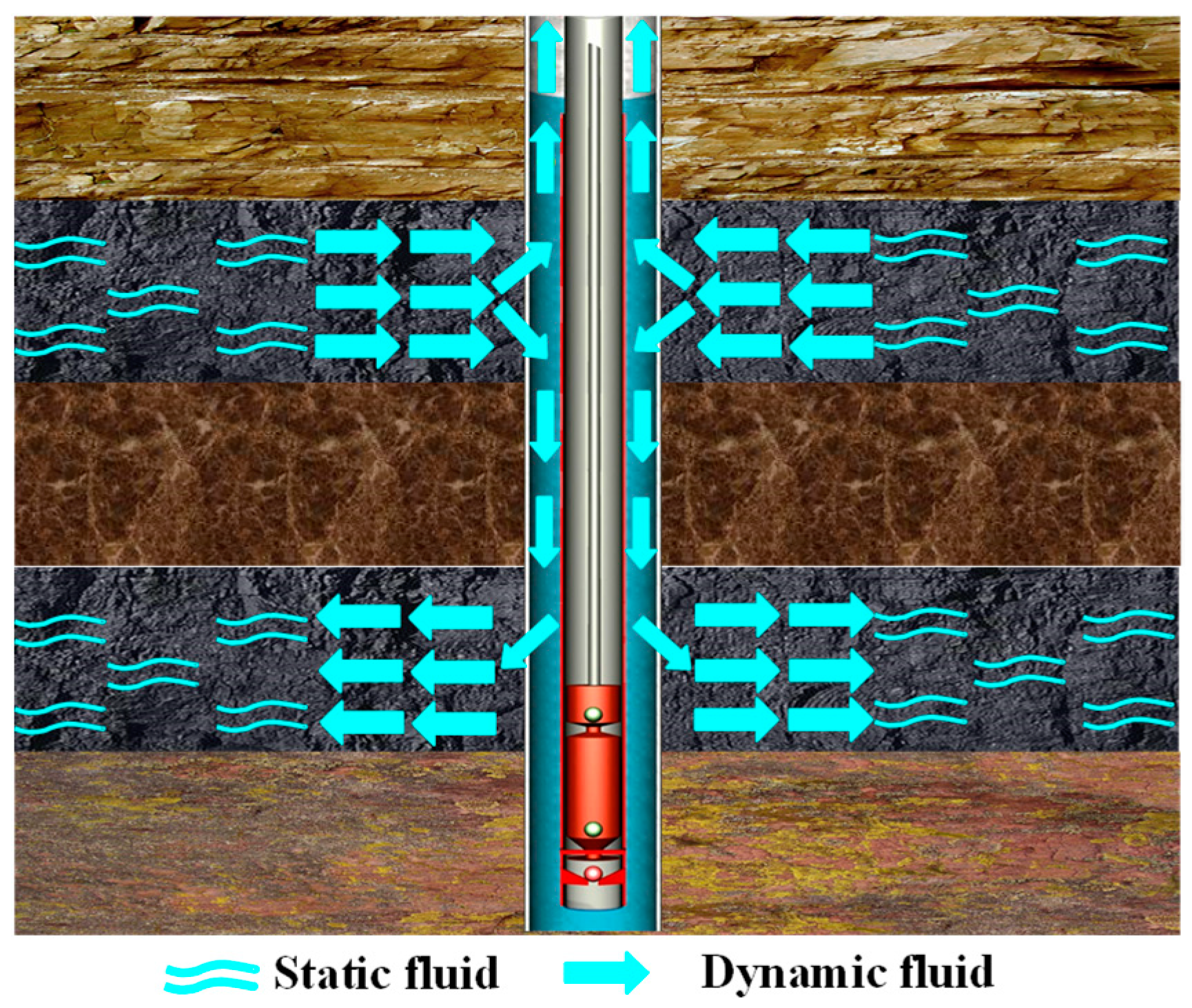
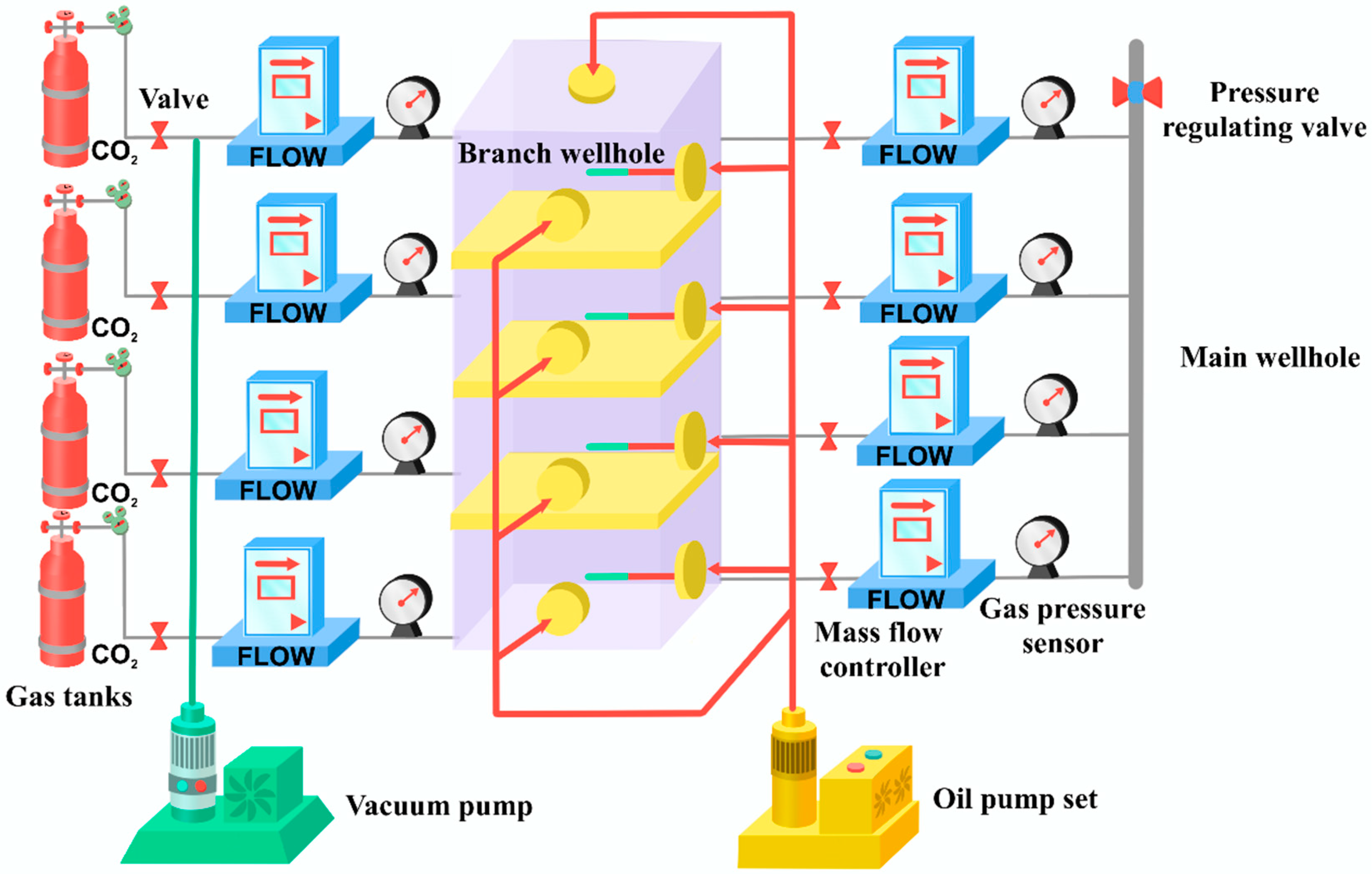



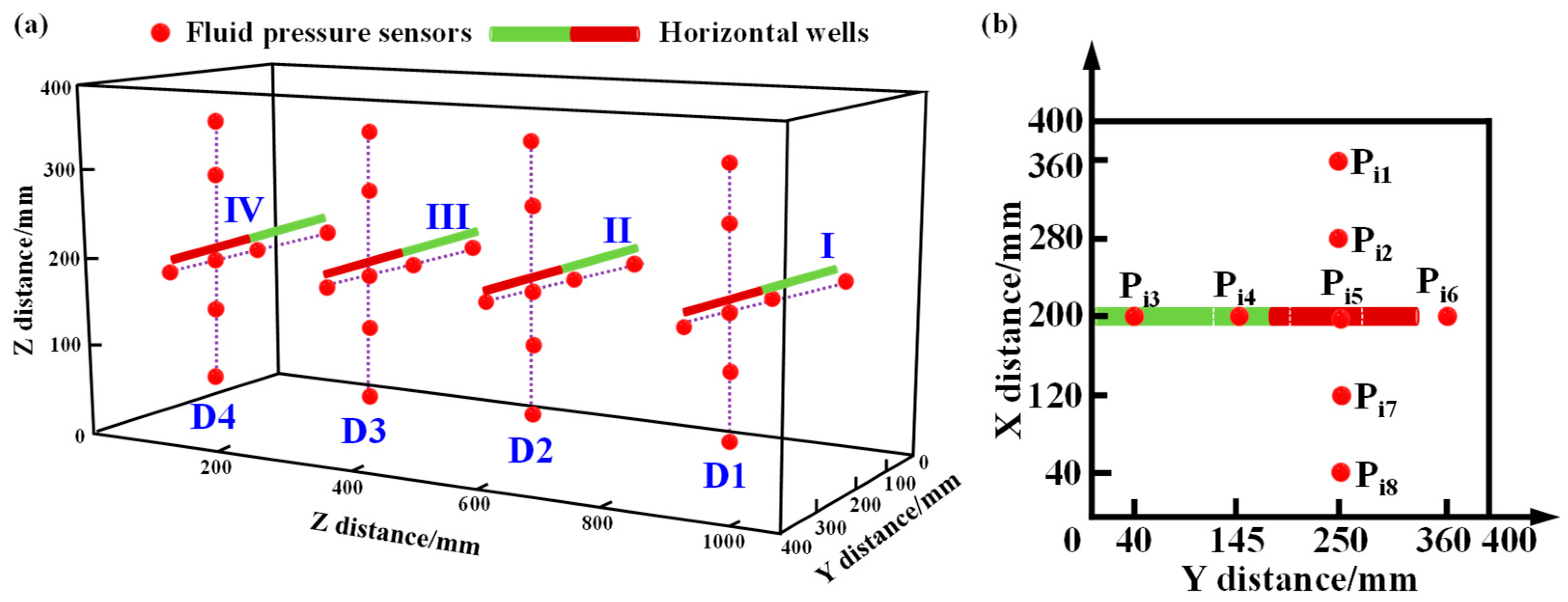

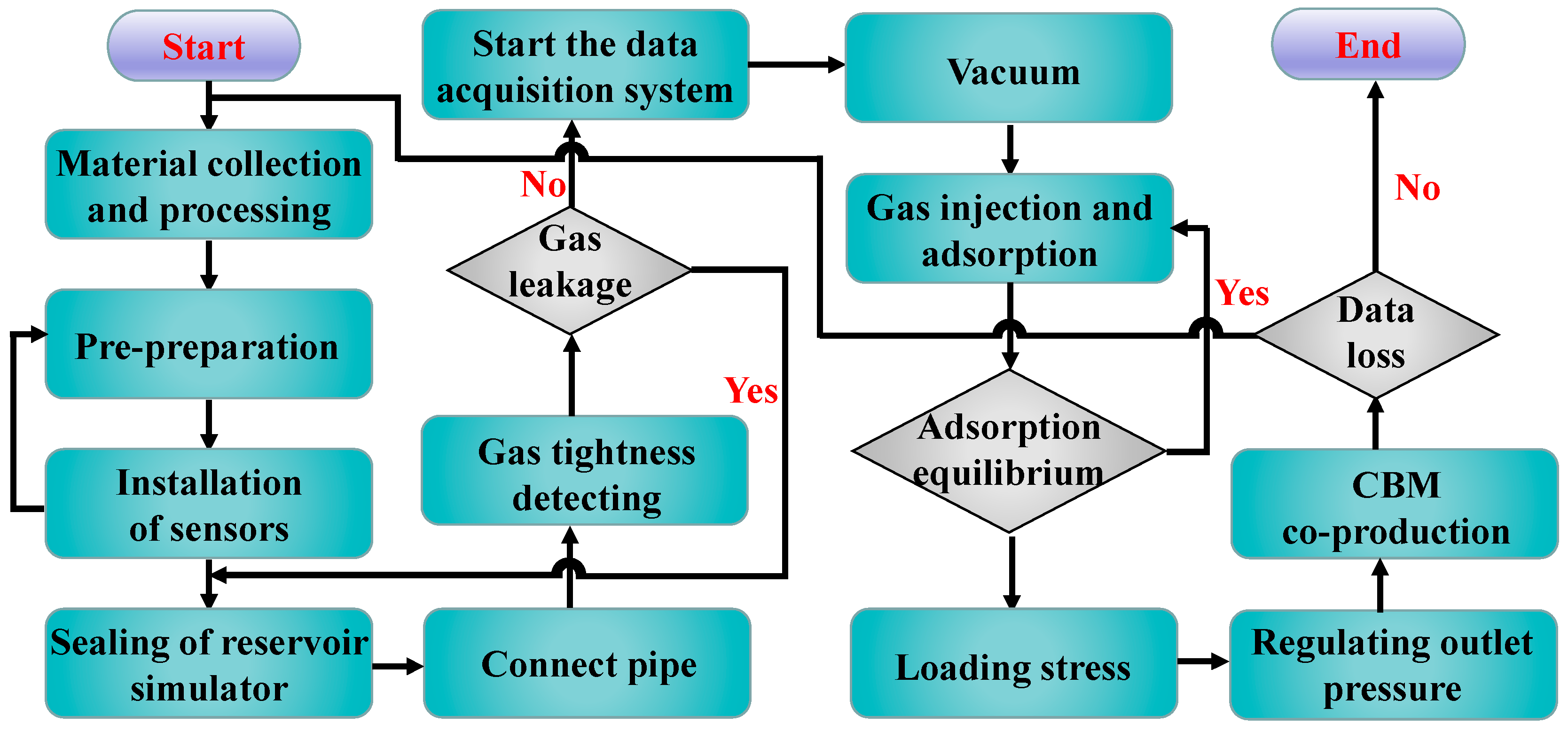
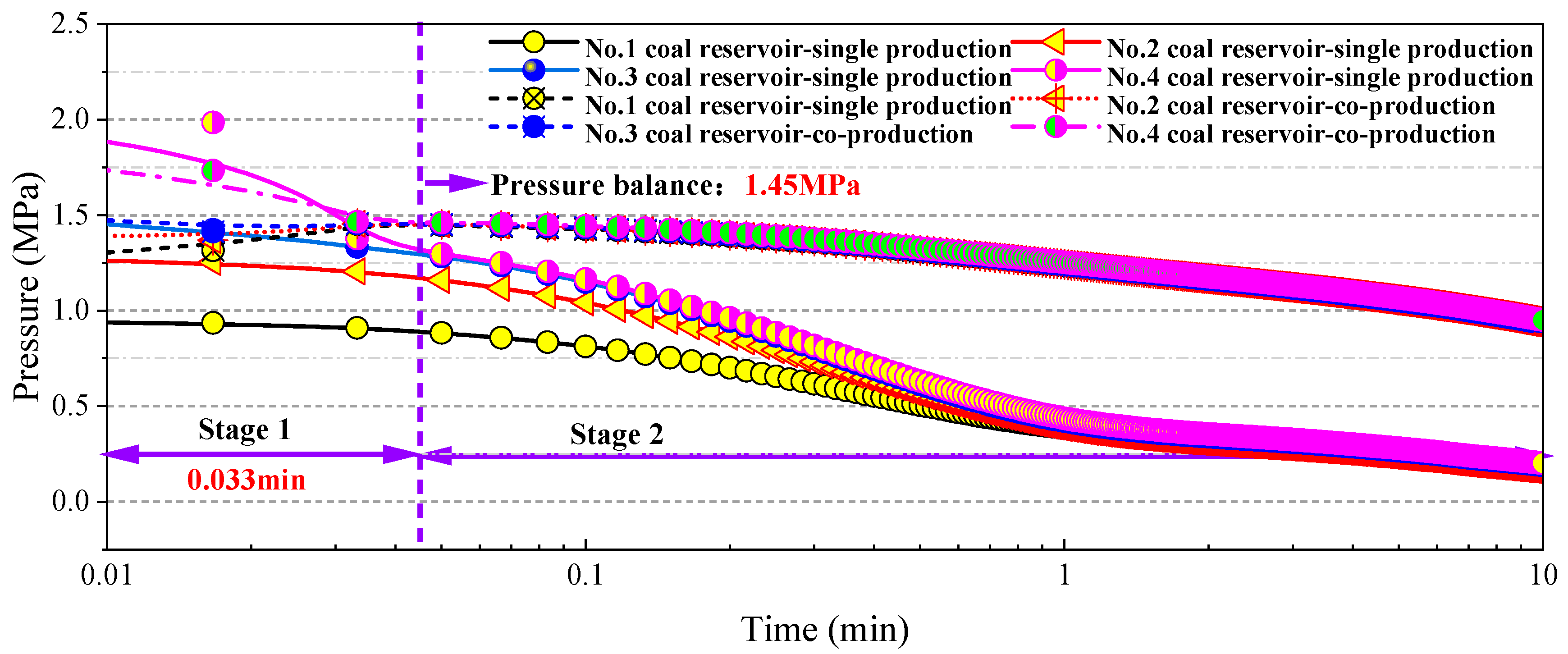

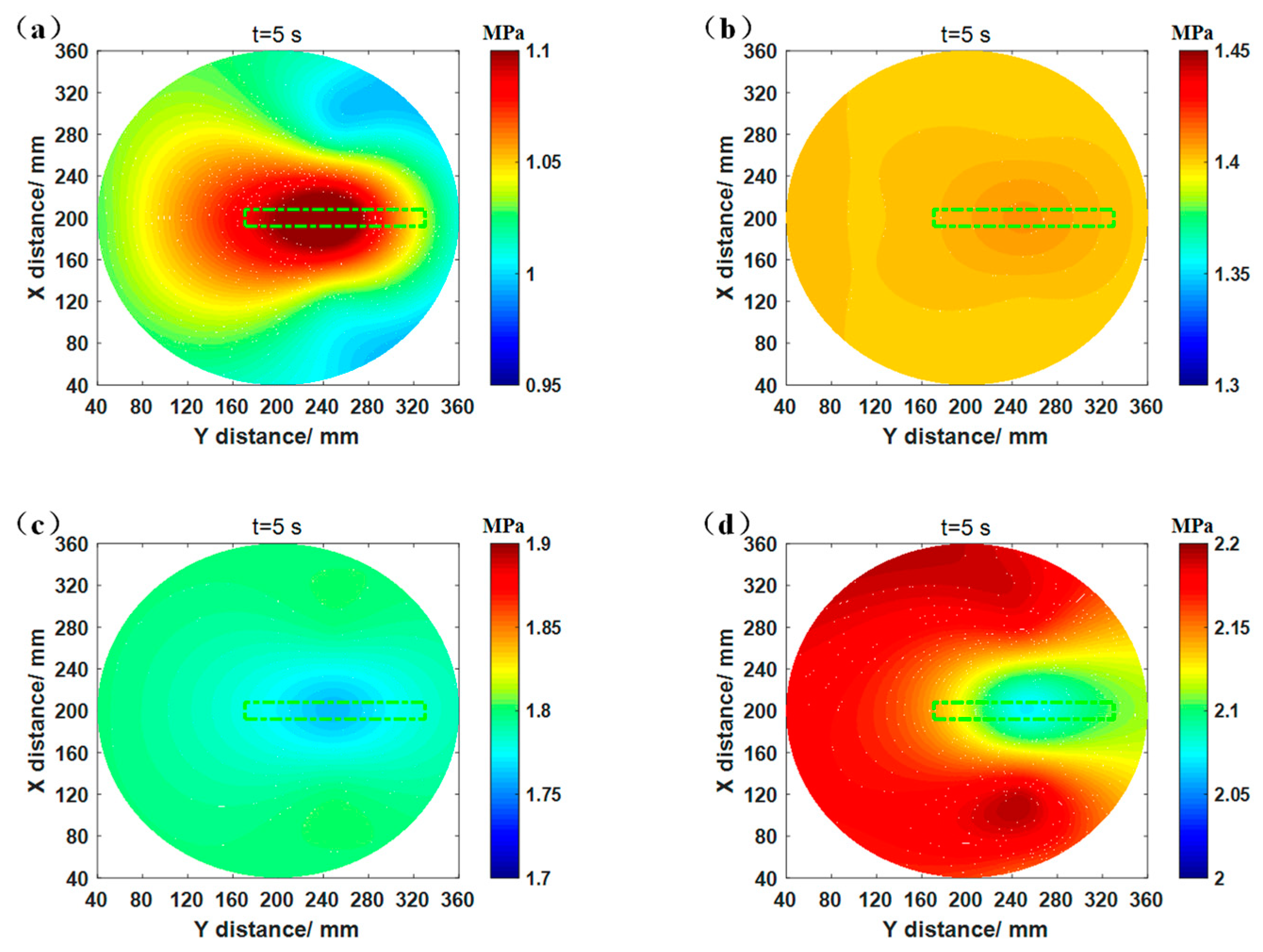
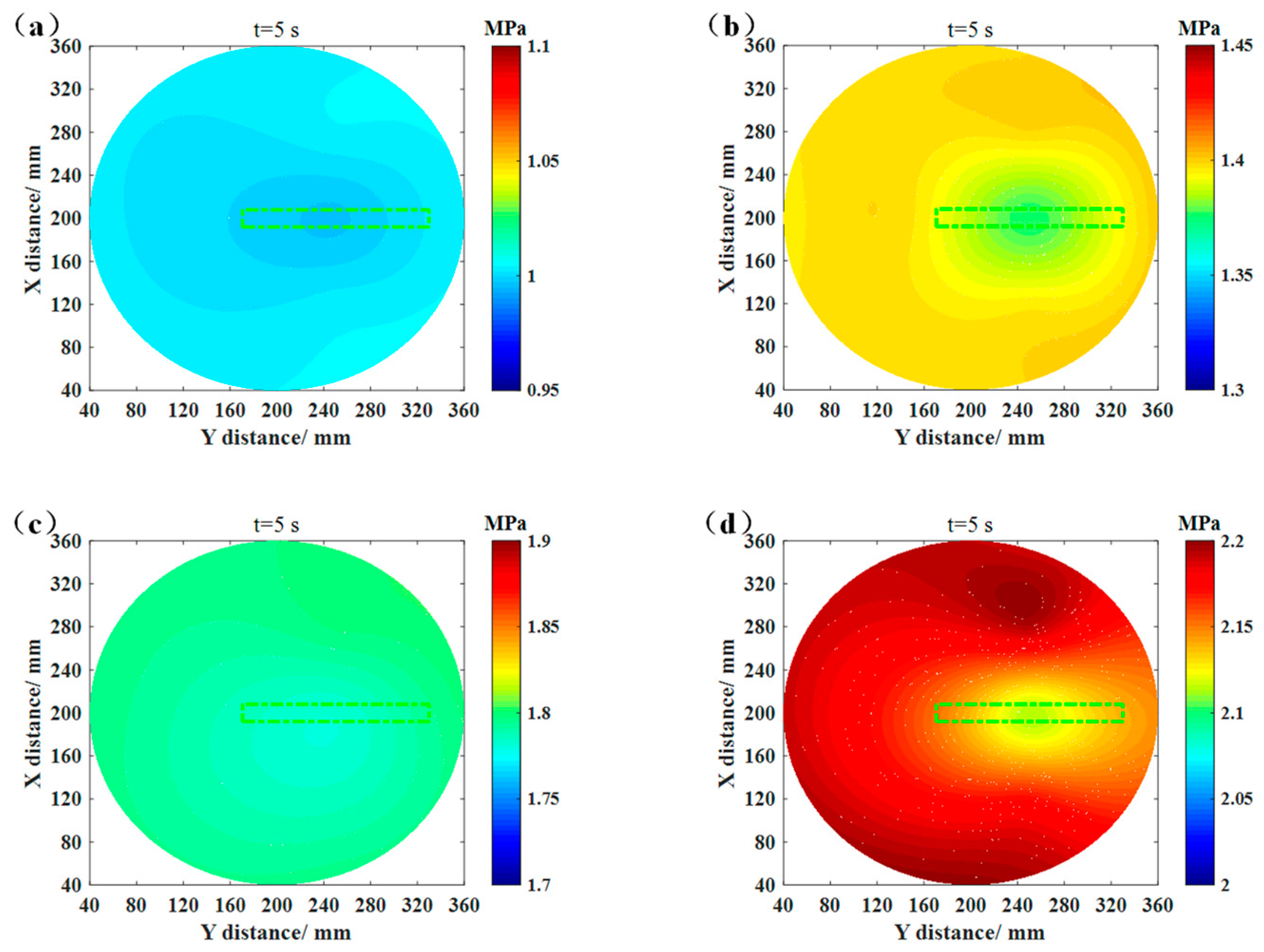
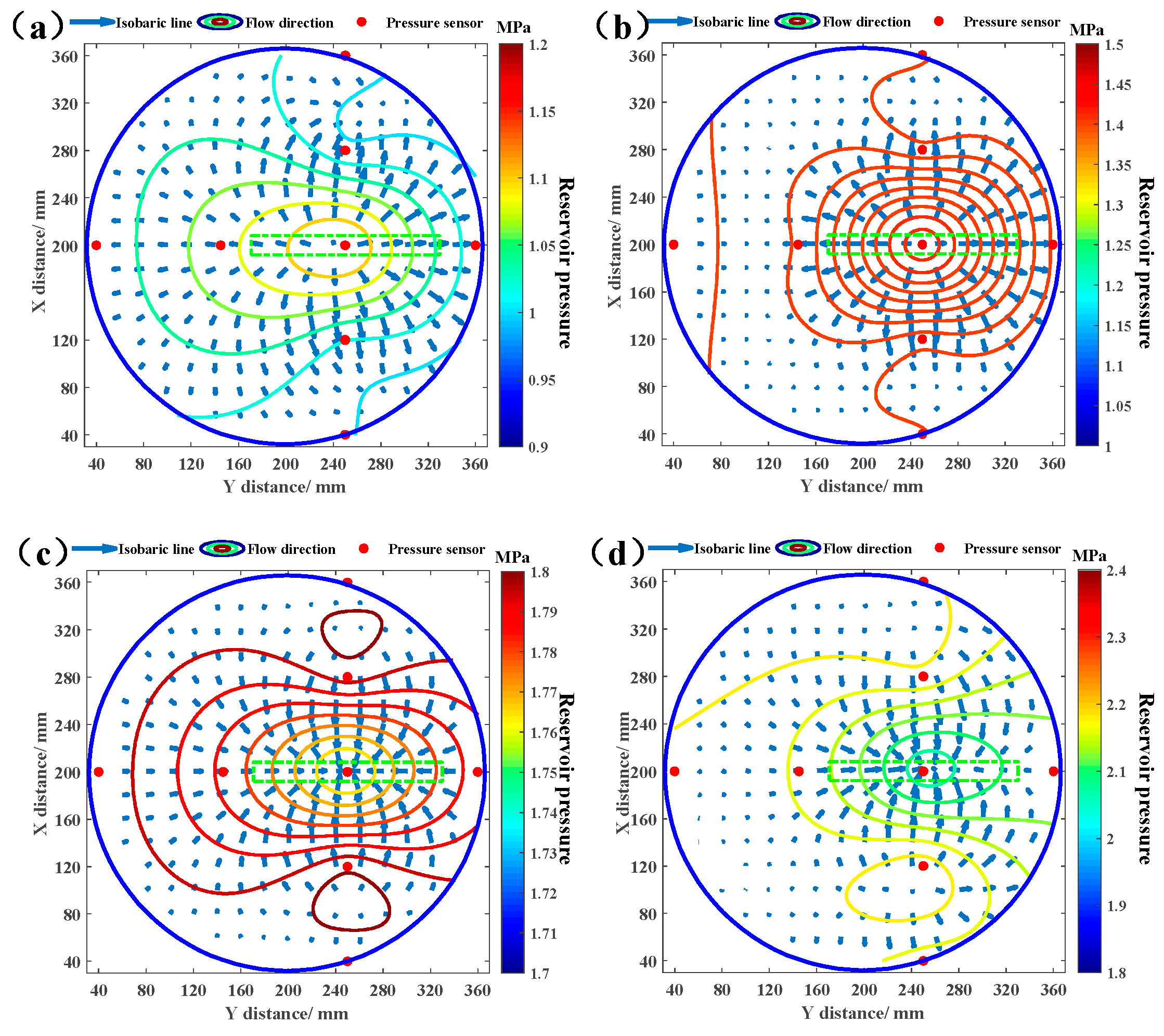
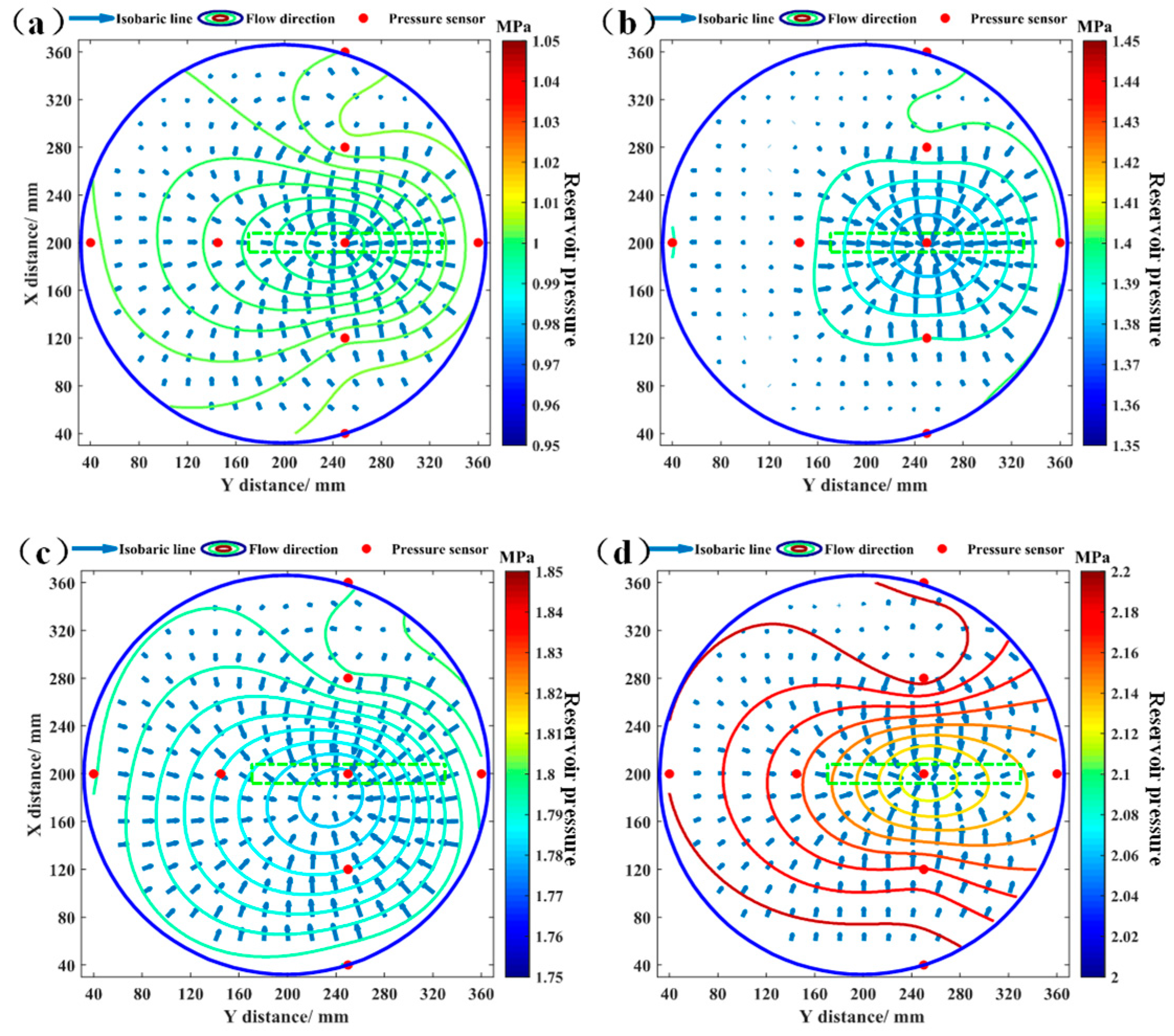



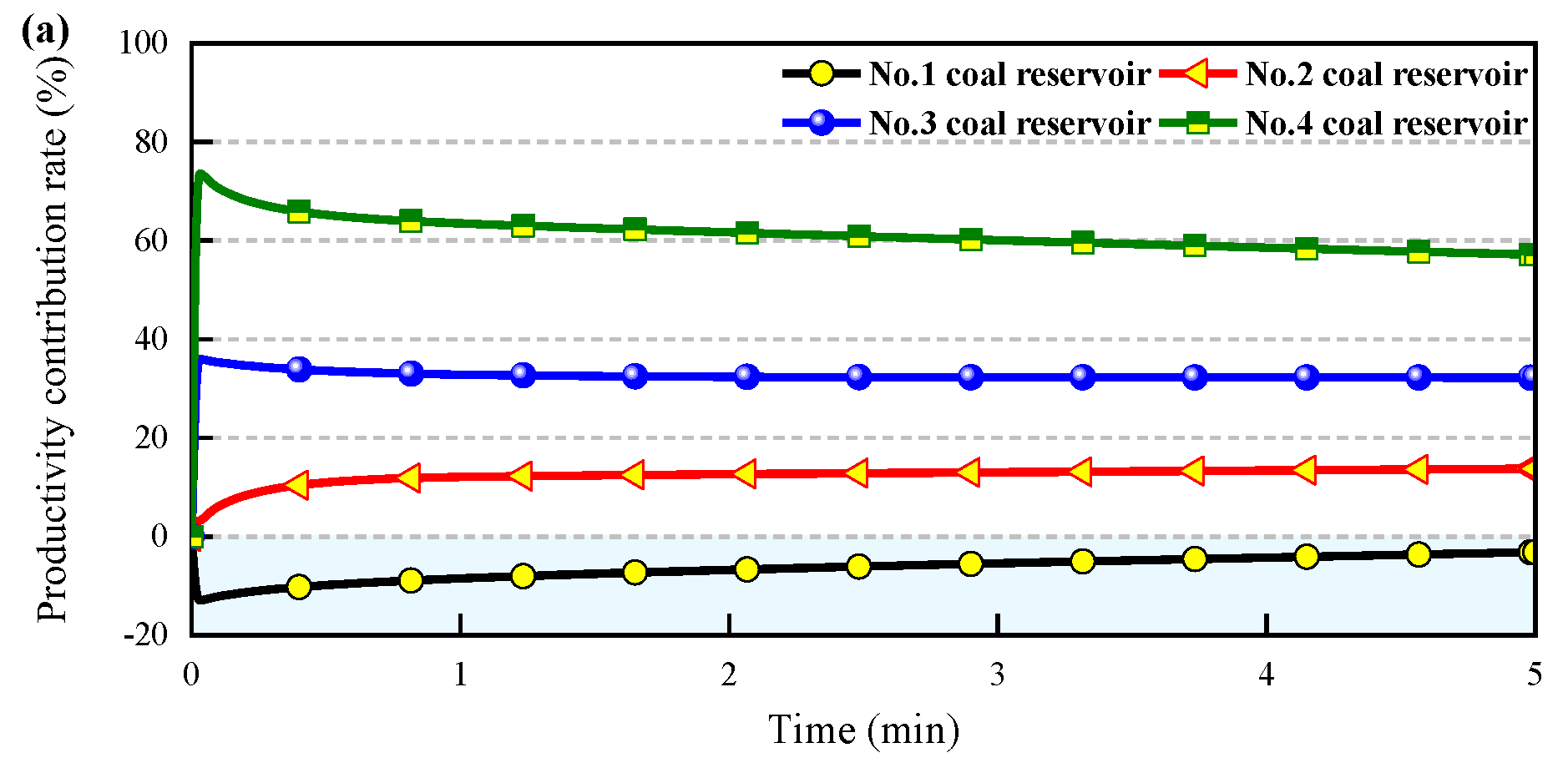

| No. | Crustal Stress (MPa) | Initial Reservoir Pressure (MPa) | Production Mode | |||||||||||
|---|---|---|---|---|---|---|---|---|---|---|---|---|---|---|
| σH1 | σH2 | σH3 | σH4 | σv | σh1 | σh2 | σh3 | σh4 | PI | PII | PIII | PIV | ||
| 1 | 5.0 | 4.0 | 3.0 | 1.0 | 1.4 | 1.8 | 2.2 | Single production | ||||||
| 2 | Co-production | |||||||||||||
Disclaimer/Publisher’s Note: The statements, opinions and data contained in all publications are solely those of the individual author(s) and contributor(s) and not of MDPI and/or the editor(s). MDPI and/or the editor(s) disclaim responsibility for any injury to people or property resulting from any ideas, methods, instructions or products referred to in the content. |
© 2025 by the authors. Licensee MDPI, Basel, Switzerland. This article is an open access article distributed under the terms and conditions of the Creative Commons Attribution (CC BY) license (https://creativecommons.org/licenses/by/4.0/).
Share and Cite
Ren, J.; Li, Q.; Zhang, M.; Xu, J.; Li, Y.; Yang, P. On the Fluid Behavior Response Characteristics During Early Stage of CBM Co-Production in Superimposed Pressure Systems: Insights from Experimental Analysis. Processes 2025, 13, 1095. https://doi.org/10.3390/pr13041095
Ren J, Li Q, Zhang M, Xu J, Li Y, Yang P. On the Fluid Behavior Response Characteristics During Early Stage of CBM Co-Production in Superimposed Pressure Systems: Insights from Experimental Analysis. Processes. 2025; 13(4):1095. https://doi.org/10.3390/pr13041095
Chicago/Turabian StyleRen, Jiewei, Qixian Li, Meichang Zhang, Jiang Xu, Yang Li, and Pengbin Yang. 2025. "On the Fluid Behavior Response Characteristics During Early Stage of CBM Co-Production in Superimposed Pressure Systems: Insights from Experimental Analysis" Processes 13, no. 4: 1095. https://doi.org/10.3390/pr13041095
APA StyleRen, J., Li, Q., Zhang, M., Xu, J., Li, Y., & Yang, P. (2025). On the Fluid Behavior Response Characteristics During Early Stage of CBM Co-Production in Superimposed Pressure Systems: Insights from Experimental Analysis. Processes, 13(4), 1095. https://doi.org/10.3390/pr13041095





